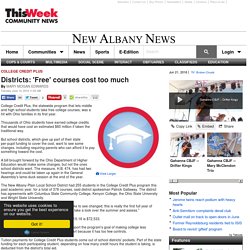

College Credit Plus. LIMA — Local superintendents agree that while College Credit Plus is overall providing more positives than negatives, there are also problems that still need ironed out as more and more students participate.

Districts: 'Free' courses cost too much. College Credit Plus, the statewide program that lets middle and high school students take free college courses, was a hit with Ohio families in its first year.

Thousands of Ohio students have earned college credits that would have cost an estimated $60 million if taken the traditional way. But school districts, which give up part of their state per-pupil funding to cover the cost, want to see some changes, including requiring parents who can afford it to pay something toward the cost. A bill brought forward by the Ohio Department of Higher Education would make some changes, but not the ones school districts want.
The measure, H.B. 474, has had two hearings and could be taken up again in the General Assembly's lame-duck session at the end of the year. The New Albany-Plain Local School District had 255 students in the College Credit Plus program this past academic year, for a total of 378 courses, said district spokesman Patrick Gallaway. Ohio schools seek changes to college credit program. The Ohio Department of Education is pushing legislation that would makes changes to a statewide program offering free college credit to middle- and high-schoolers.

Changes to the College Credit Plus program that are backed by the department include eliminating a waiver that allows school groups to negotiate with colleges to set lower credit-hour fees, The Columbus Dispatch reported ( Another provision would allow a pilot program under which students who aren't ready for college could take remedial courses. But lobbyists for some school organizations say the changes they want are not in the bill . While they support the program's goal of making college less expensive, school groups say it costs districts too much. Tuition payments for the program's students come out of the districts' pockets, along with other expenses. Other changes include requiring parents who can afford it to pay something toward the cost. More money going to teachers interested in College Credit Plus. Close to 100 local high school teachers could become eligible to teach College Credit Plus courses in the next two years, thanks to state grants involving three local colleges.

Wright State University, in partnership with Clark State Community College, earned a $702,000 Straight-A innovation grant that will allow 60 or more high school teachers to take the required graduate courses tuition-free. Sinclair Community College earned a similar state grant of $228,000, augmenting $100,000 the college dedicated on its own a year ago. Wright State is also putting $162,000 of its own funding toward the effort. “Providing this funding for teacher credentialing will ultimately allow more students to take advantage of College Credit Plus (at their high schools), which is great news for students and families looking to save potentially thousands on the cost of a college education,” said Ohio Department of Higher Education Chancellor John Carey.
Many schools involved Hurdles for teachers? Free college courses cost Ohio schools too much, districts say. College Credit Plus, the statewide program that lets middle and high school students take free college courses, was a hit with Ohio families in its first year.

Thousands of Ohio students have earned college credits that would have cost an estimated $60 million if taken the traditional way. But school districts, which give up part of their state per-pupil funding to cover the cost, want to see some changes, including requiring parents who can afford it to pay something toward the cost. A bill brought forward by the Department of Higher Education would make some changes, but not the ones school districts want. The measure, H.B. 474, has had two hearings and could be taken up again in the General Assembly’s lame-duck session at the end of the year. Lobbyists for school organizations say they support the program’s goal of making college less expensive, but it’s costing them too much, in part because it has too few controls.
“Some of those college texts can run $400,” Asbury said. Free, early college credits a big hit. Ohio high-school students, and even some middle-schoolers, flocked to the state’s new early-college program this fall, doubling the number who enrolled in a predecessor program.

Turns out, students and parents are keen to earn college credit at no cost if they know the opportunity exists. When lawmakers created College Credit Plus in the 2013-15 budget, part of the idea was to make sure all Ohio high-schoolers — not just those in school districts that approve of early-college programs — were made aware of it. Under the patchwork of dual-enrollment programs that existed before, “Some districts encouraged it and others didn’t,” said John Carey, chancellor of the Ohio Department of Higher Education. College Credit Plus established a uniform, statewide program and required every school district to explain the opportunity in a public meeting. “The main idea is for students and families to have choices,” Carey said.
Mcedward@dispatch.com @MaryMoganEdward.